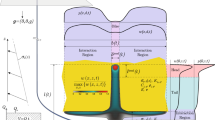In the present work, by the methods of mathematical and numerical analysis, the author has investigated the regularities of the influence of the processes of mass exchange between rock clusters and fractures in porous fractured media on the form of inflow and pressure-buildup curves and their time derivatives. It has been shown that in addition to the traditionally used parameter governing the relation of the compressibilities of the fracture space and the rock clusters, it is expedient to take account of the compressibility of the pore and fracture space under the action of the difference of pressures in the clusters and fractures.
The author has established the governing parameters of the mass-exchange processes and their influence on the dynamics of pressure curves, which is manifested in the nonmonotonicity of the derivatives of pressurebuildup curves with respect to the Horner variable. It has been shown that this derivative reaching asymptotically the limiting value is preceded by the formation of the minimum region of the derivative. It has been noted that the nonmonotonic character of the derivatives may be fully or partially smoothed by the influence of the wellbore due to the compressibility of the fluid in the below-packer zone of the wellbore and the influence of the skin factor, i.e., by the change in the permeability and porosity properties of the near-wellbore zone. The obtained results can be used for more correct interpretation of the data of hydrodynamic testing of wells in porous fractured reservoirs.
Similar content being viewed by others
References
T. D. Golf-Rakht, Fundamentals of Oil Field Geology and the Exploitation of Fractured Reservoirs [in Russian], Nedra, Moscow (1986).
G. I. Barenblatt, V. M. Entov, and V. M. Ryzhik, Motion of Fluids and Gases in Natural Formations [in Russian], Nedra, Moscow (1984).
Yu. P. Zheltov, Mechanics of an Oil- and Gas-Bearing Bed [in Russian], Nedra, Moscow (1975).
H. S. Carslaw and J. Jaeger, Conduction of Heat in Solids, Oxford University Press (1959).
M. Abramovits and I. Stigan (Eds.), Handbook of Special Functions [Russians translation], Nauka, Moscow (1979).
D. R. Horner, Pressure build-up in wells, Proc. Third World Petroleum Congress, The Hague, Section 2 (1951), pp. 503−521.
D. Bourdet, J. A. Ayoub, and Y. M. Pirard, Use of pressure derivative in well-test-interpretation, Paper SPE 12777, SPE Facilities & Engineering, June 1989, pp. 293−302.
A. M. Svalov and T. N. Tsagan-Mandjiev, Improved Horner method for processing pressure curves in hydrodynamic well testing, Geol., Geofiz. Razrab. Neft. Gaz. Mestorozhd., No. 6, 30–33 (2017).
Author information
Authors and Affiliations
Corresponding author
Additional information
Translated from Inzhenerno-Fizicheskii Zhurnal, Vol. 94, No. 2, pp. 393–399, March–April, 2021.
Rights and permissions
About this article
Cite this article
Svalov, A.M. Features of Inflow and Pressure-Buildup Curves in Porous Fractured Reservoirs. J Eng Phys Thermophy 94, 377–383 (2021). https://doi.org/10.1007/s10891-021-02307-8
Received:
Published:
Issue Date:
DOI: https://doi.org/10.1007/s10891-021-02307-8




